1. Virupaksha Temple

This temple stands as a testament to the architectural brilliance of the Vijayanagar Empire, dedicated to Lord Shiva, known as Virupaksha. It has remained in continuous worship since its inception in the 7th century, making it one of the oldest functioning Hindu temples. The temple’s towering gopura (gateway tower) offers a panoramic view of Hampi, and its intricate carvings narrate episodes from Hindu mythology.
2. Vittala Temple Complex

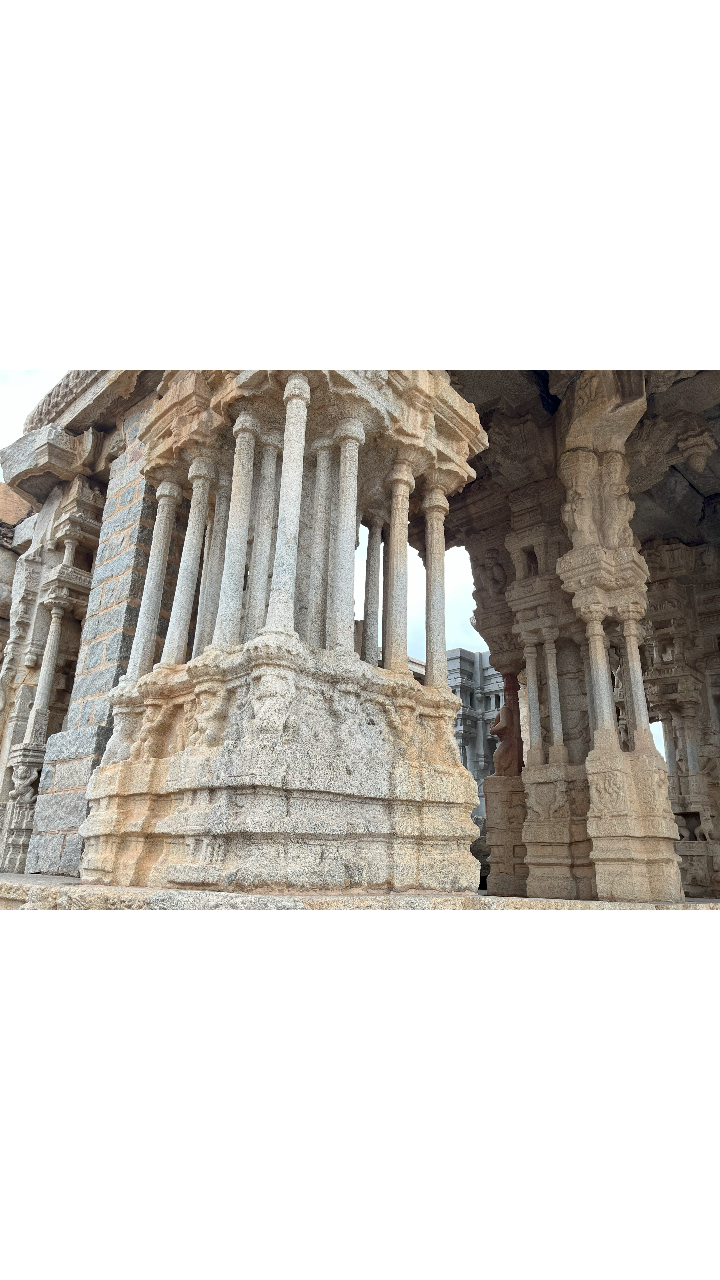
The Vittala Temple is celebrated for its extraordinary craftsmanship and the iconic stone chariot, which has become a symbol of Karnataka’s heritage. The temple’s musical pillars, which produce musical notes when struck, demonstrate the advanced acoustical knowledge of its builders. The complex showcases a blend of various architectural styles, reflecting the cosmopolitan nature of the Vijaynagara Empire.
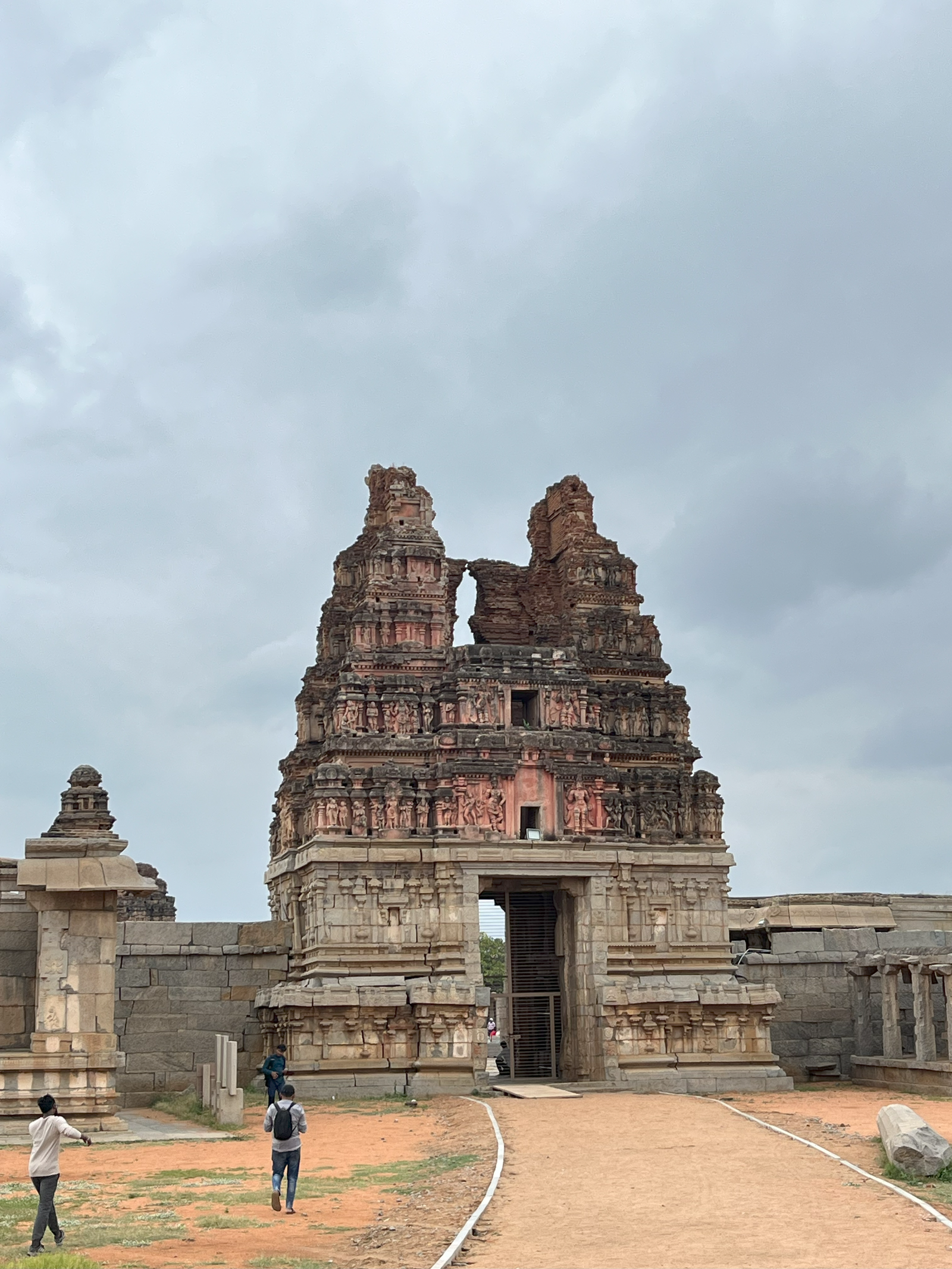

3. Hemakuta Hill Temples
Hemakuta Hill is dotted with an assortment of temples dating back to the early Vijaynagara period. The hill provides a tranquil spot for sunset views and is known for its monolithic structures and pavilions. The temples exhibit a pre-Vijaynagara architectural style, characterized by their simplicity and the experimental basis for the more elaborate structures that followed.
4. Hazara Rama Temple

Unique for its elaborate frescoes depicting the Ramayana, the Hazara Rama Temple served as a royal chapel. The walls are covered with bas-reliefs narrating the epic tale of Rama, showcasing the artistic excellence of the period. This temple, situated in the heart of the royal enclosure, underscores the Vijaynagara rulers’ devotion to Hindu epics.
5. Krishna Temple
X Commissioned by King Krishnadevaraya in 1513 to commemorate his victory over the kingdom of Udayagiri, the Krishna Temple houses an idol of Balakrishna. The temple complex is adorned with intricate carvings of mythological themes and has a large pushkarani (sacred water tank). The detailed carvings on the temple pillars are a testament to the craftsmanship of Vijaynagara sculptors.
6. Achyutaraya Temple
Tucked between Matanga Hills and Gandhamadana, this temple boasts of majestic architecture and was dedicated to Lord Tiruvengalanatha. The temple complex, less frequented by tourists, offers a serene atmosphere and provides insight into the city’s urban planning. The courtyards, bazaars, and intricate carvings on the temple walls reflect the social and religious life of Hampi.
7. Kadalekalu Ganesha
The monolithic statue of Ganesha, carved out of a single rock, is named after the Bengal gram (kadalekalu) due to the shape of its belly. Located on the slopes of Hemakuta Hill, this 4.5 meters high statue showcases the skillful artistry of Vijayanagara sculptors. The sanctum around the statue is an open pavilion with slender, ornately carved pillars.
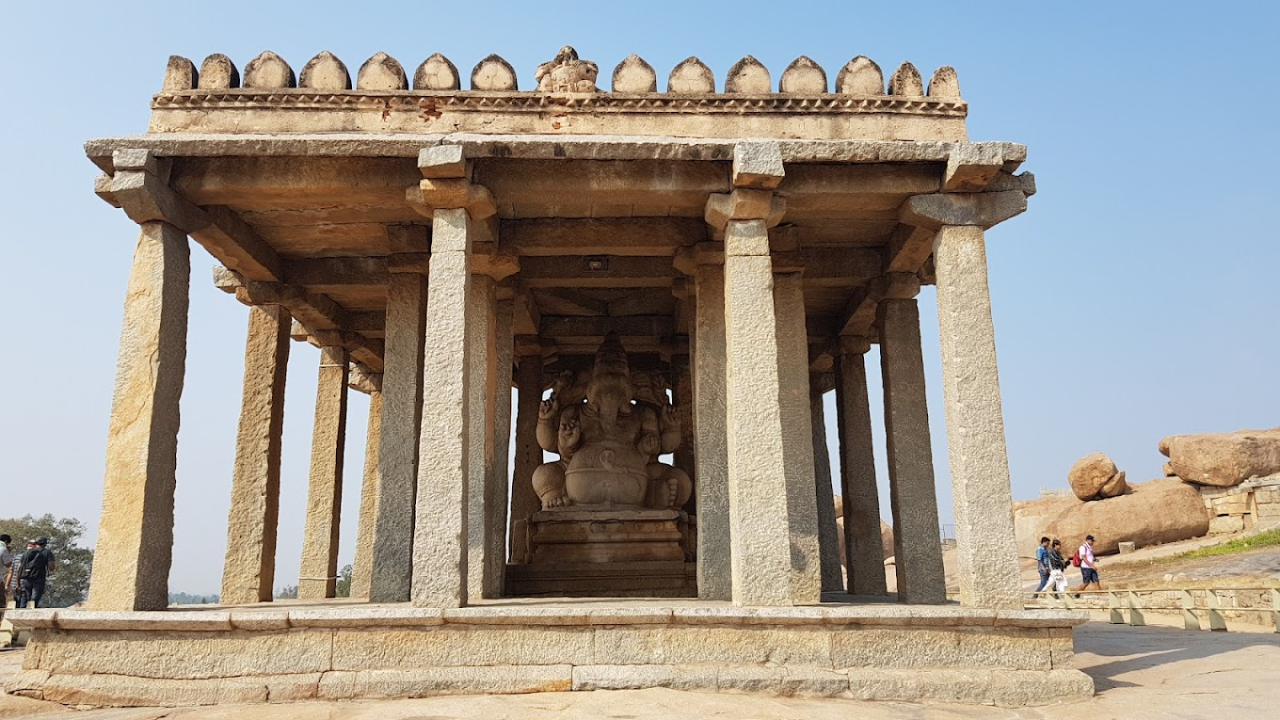
8. Sasivekalu Ganesha
Another impressive monolithic sculpture of Lord Ganesha, this statue stands at 2.4 meters and is enclosed within an open-pillared pavilion. According to mythology, this statue represents Ganesha’s form when he tied a snake around his stomach as a belt to prevent his stomach from bursting after overeating. The intricate carvings on the pillars and the nearby sculptures add to its allure.

9. Elephant Stables
Serving as the royal elephants’ shelter, the Elephant Stables are a remarkable example of Islamic architectural influence on the Vijaynagara Empire. The stables feature domed chambers, each designed to house the royal elephants. This structure highlights the importance of elephants in the royal ceremonies and military campaigns of the Vijayngara rulers.
10. Lotus Mahal
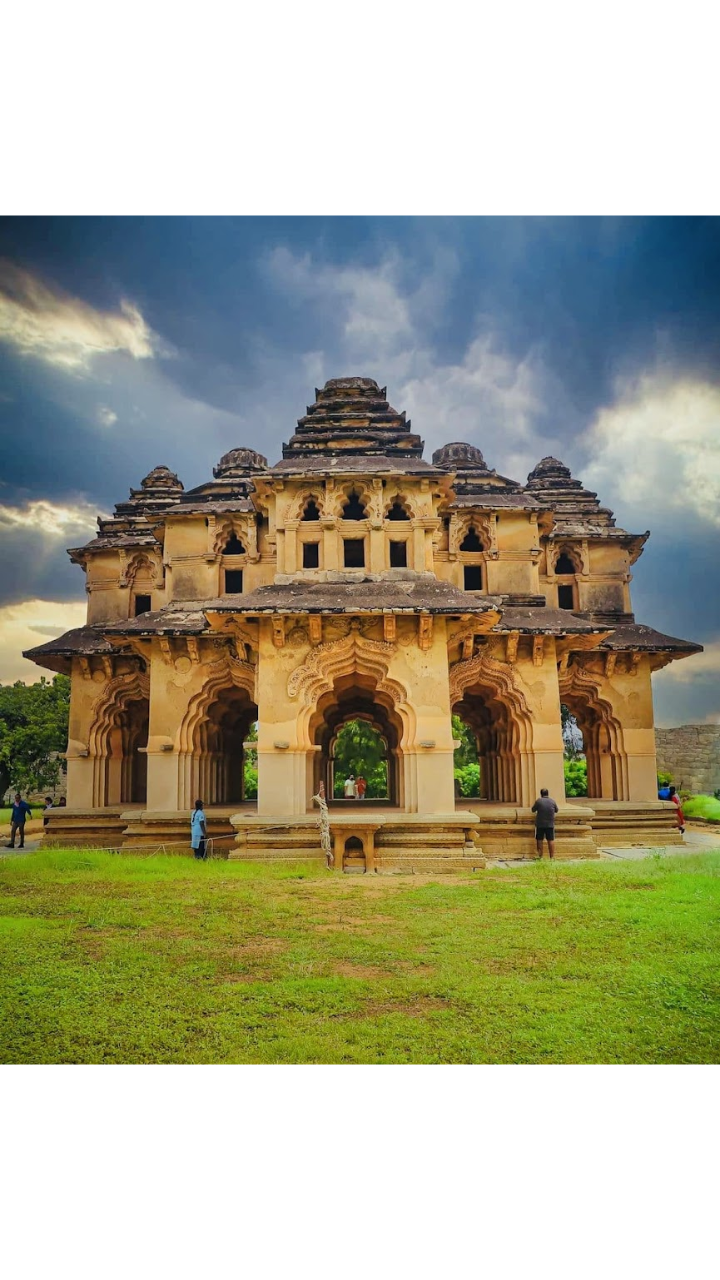
This architectural marvel is part of the Zenana Enclosure and stands out for its Indo-Islamic design, showcasing the syncretic culture of Hampi. The Lotus Mahal, named so because of its lotus-like dome, served as a socializing area for the royal women. Its airy pavilions and geometrically arranged arches demonstrate a sophisticated understanding of space and aesthetics.
11. Queen’s Bath
Built for the royal family’s private use, the Queen’s Bath exemplifies the luxurious lifestyle of the Vijaynagara royalty. Despite its plain exterior, the interior is stunning, with a large pool surrounded by ornate balconies and arched corridors. This architectural piece reflects the fusion of Hindu and Islamic styles, characteristic of the later Vijaynagara period.
12. Lakshmi Narasimha or Ugra Narasimha Statue

The largest monolithic sculpture in Hampi, this statue depicts Lord Narasimha sitting in a cross-legged position. Carved out of a single block of stone, the sculpture originally featured Goddess Lakshmi sitting on Narasimha’s lap, though only a small portion of her form remains today. The intense expression of Narasimha and the detailed carvings on the statue highlight the sculptural excellence of Vijaynagara artisans.
13. Badavi Linga
Standing adjacent to the Lakshmi Narasimha statue, the Badavi Linga is the largest monolithic Shiva Linga in Hampi. The Linga is bathed in water channeled through an ancient aqueduct, and the sanctum remains submerged. This sacred symbol of Lord Shiva is revered by devotees and represents the timeless spiritual heritage of Hampi.
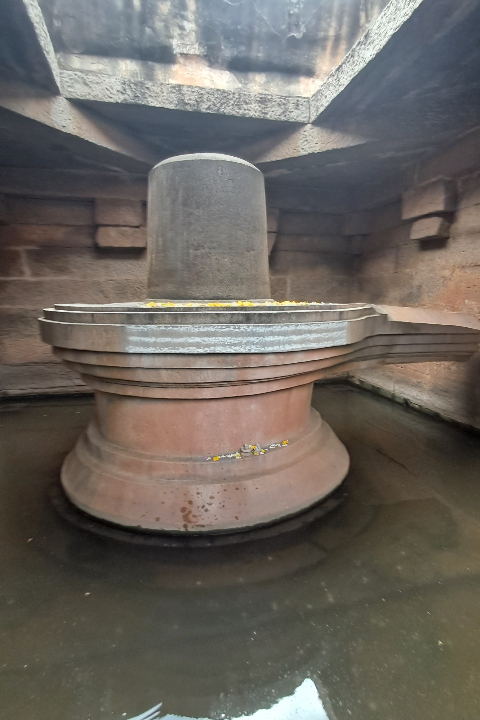
14. Stepped Tank
Discovered during excavations in the Royal Enclosure, this stepped tank was used for religious ceremonies and rituals. Constructed using finely chiselled black schist stone blocks, the geometric precision and symmetry of the steps are a testament to the advanced engineering skills of the Vijayanagara period. The tank’s pristine condition and architectural beauty make it a fascinating site for visitors.
15. Mahnavami Dibba
Also known as the Dasara Dibba, this grand platform was used by the kings to observe the festivities of the Mahnavami festival. The platform is adorned with detailed carvings depicting daily life, royal processions, and hunting scenes, offering insights into the socio-cultural life during the Vijayanagara period. The Mahnavami Dibba stands as a symbol of the empire’s prosperity and the splendour of its celebrations.
16. King’s Balance
The King’s Balance, also known as Tula Bhara, is an ancient weighing scale where kings were weighed against gold, gems, or grains, which were then distributed to priests and the needy. This practice, performed during solar and lunar eclipses, exemplifies the philanthropic aspects of Vijaynagara rulers. The structure, though simple, holds significant historical value, representing the rulers’ commitment to dharma and charity.
17. Pushkarani
Hampi is dotted with several sacred water tanks (pushkaranis) associated with the temples. These tanks, used for ritual bathing and religious ceremonies, are architectural marvels themselves, featuring geometrically intricate stepwells and ornate carvings. The pushkaranis reflect the importance of water in Hindu rituals and the advanced hydraulic engineering of the Vijaynagara Empire.

18. Monolithic Bull (Nandi)
Situated east of Virupaksha Temple, this giant sculpture of Nandi (the bull mount of Lord Shiva) gazes towards the sanctum. The monolithic Nandi, sitting on a raised platform, is a fine example of Vijayanagara sculpture. The detailed carvings on the Nandi and the surrounding pavilion speak volumes about the artistic skills and religious devotion of the era.
19. Underground Shiva Temple

The uniqueness of this temple lies in its below-ground-level construction, leading to its frequent submersion under water. The temple, dedicated to Lord Shiva, showcases the architectural diversity of Hampi and the innovative spirit of its builders. Despite its submerged state, the temple attracts visitors for its mystical ambiance and architectural beauty.
20. Prasanna Virupaksha (Underground Temple)
Also known as the Underground Shiva Temple, this structure is part of the larger Virupaksha temple complex. The temple is mostly underground, with its main sanctum below the ground level, creating a serene and secluded space for worship. The architectural design, allowing for natural light and air, demonstrates the ingenuity of its creators.
21. Coracle Crossing Point

Near the Vitthala Temple, the coracle crossing point on the Tungabhadra River showcases the traditional round boats used for crossing the river. These coracles, made of bamboo and hide, are a testament to the ingenuity and resourcefulness of the local people. The crossing point not only serves a practical purpose but also adds to the charm and historical context of Hampi.
22. Riverside Ruins
The riverside ruins include a series of Shiva Linga’s carved into the rock along the Tungabhadra River. These sacred linga’s, alongside the carvings of yali’s (mythical creatures) and geometric patterns, create a spiritual ambiance by the riverbank. The site reflects the pervasive worship of Lord Shiva in Hampi and the artistic expression of religious devotion.
23. Gejjala Mantapa
This open pavilion, located near the Vittala Temple, was used for religious functions and ceremonies. The Gejjala Mantapa, with its ornate pillars and roof, exemplifies the Vijayanagara style of architecture. The structure’s location and design suggest it may have been part of a larger ritualistic landscape, offering a glimpse into the ceremonial aspects of Hampi’s culture.

24. Sugreeva’s Cave
Associated with the epic Ramayana, Sugreeva’s Cave is believed to be the refuge of Sugreeva, the monkey king. The cave, marked by distinct carvings and paintings, connects Hampi’s historical landscape with the mythological narratives of ancient India. The site is a blend of natural beauty and mythological significance, attracting those interested in the epic tales of Ramayana.
25. Anjanadri Hill
Considered the birthplace of Lord Hanuman, Anjanadri Hill is a significant pilgrimage site within the Hampi region. The hill offers panoramic views of the surrounding ruins and landscapes. The climb to the top is marked by a series of steps leading to a small temple dedicated to Hanuman, providing a spiritual experience amidst the natural beauty and historical ruins of Hampi.


